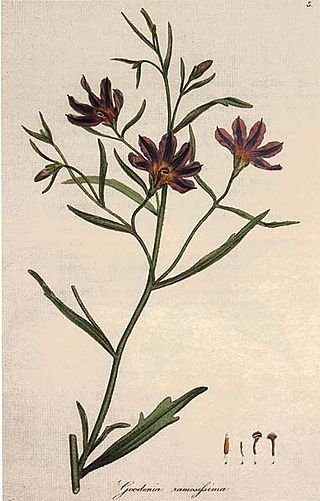
Goodeniaceae is a family of flowering plants in the order Asterales. It contains about 404 species in twelve genera. The family is distributed mostly in Australia, except for the genus Scaevola, which is pantropical. Its species are found across most of Australia, being especially common in arid and semi-arid climates.

Dampiera is a genus of about 70 species of flowering plants in the family Goodeniaceae, all of which are endemic to Australia. Plants in the genus Dampiera are subshrubs or herbs with sessile leaves, flowers with five small sepals and blue, violet or pink, rarely white, two-lipped flowers.

Goodenia is a genus of about two hundred species of flowering plants in the family Goodeniaceae. Plants in this genus are herbs or shrubs, mostly endemic to Australia. The leaves are variably-shaped, the flowers arranged in small groups, with three or five sepals, the corolla bilaterally symmetrical and either fan-shaped with two "lips" or tube-shaped. The petals are usually yellow to white, the stamens free from each other and the fruit a capsule.

Dampiera stricta commonly known as blue dampiera, is a flowering plant in the family Goodeniaceae. It is a small sub-shrub with variable leaves and mostly blue, mauve or purple flowers.

Dampiera dysantha, the shrubby dampiera, is an undershrub in the family Goodeniaceae. The species grows to 70 cm high The flowers are blue, or occasionally white to lilac and are covered on the outside with grey and rusty hairs. These generally appear between September and October in its native range.

Dampiera hederacea, commonly known as the karri dampiera, is an erect perennial herb in the family Goodeniaceae. The species, which is endemic to the south-west of Western Australia, is a low spreading shrub which reaches 40 cm (16 in) across. It produces blue flowers between August and January in its native range.

Dampiera altissima, commonly known as tall dampiera, is an erect perennial herb of the family Goodeniaceae and is native to Western Australia. It is a perennial herb that generally grows to a height of up to 0.5 m and has flat, green-grey leaves. The leaves are mostly round and are between 8-60 mm long. Dampiera altissima flowers during the winter and spring, unveiling small blue-purple flowers. The herb is a ground cover plant found growing on the sandplains, laterite and sandstone of the southwestern region of Western Australia, most common in the Geraldton area north of Perth. The species is sometimes grown as an ornamental plant and is listed as “not threatened”.

Roger Charles Carolin is a botanist, pteridologist and formerly an associate professor at Sydney University. He was appointed as a lecturer in botany at the University of Sydney in 1955 earned a Ph.D from Sydney University in 1962 with a thesis on the floral morphology of the campanales, and retired as an associate professor in 1989.

Scaevola acacioides, is an erect, spreading shrub in the family Goodeniaceae.

Dampiera candicans is a plant in the family Goodeniaceae, native to Western Australia and the Northern Territory.

Dampiera alata is a plant in the family Goodeniaceae, native to Western Australia.
Goodenia muelleriana is a species of flowering plant in the family Goodeniaceae and is endemic to the north-west of Western Australia. It is an ascending to erect herb with elliptic to lance-shaped leaves at the base of the plant, and racemes of yellow flowers.
Goodenia neogoodenia is a species of flowering plant in the family Goodeniaceae and is endemic to the western part of Western Australia. It is a prostrate, annual herb with round to heart-shaped or rhombic leaves and racemes or spikes of small, brownish flowers.
Goodenia peacockiana is a species of flowering plant in the family Goodeniaceae and is endemic to semi-arid areas of inland Western Australia. It is a prostrate to low-lying annual herb with elliptic to lance-shaped leaves with toothed or lobed edges, and racemes of yellow flowers, often with darker markings.
Goodenia prostrata is a species of flowering plant in the family Goodeniaceae and is endemic to inland parts of Western Australia. It is a prostrate herb with toothed, lance-shaped leaves at the base of the plant and racemes of yellow flowers with a brownish centre.

Goodenia watsonii is a species of flowering plant in the family Goodeniaceae and is endemic to the south-west of Western Australia. It is a perennial herb with egg-shaped to elliptic leaves mostly at the base of the plant, and thyrses of white, cream-coloured or bluish flowers.
Goodenia wilunensis is a species of flowering plant in the family Goodeniaceae and is endemic to central regions of Western Australia. It is an ascending to prostrate annual herb covered with silky hairs and has elliptic to egg-shaped leaves with the narrower end towards the base, and racemes of yellow flowers with purplish markings.

Dampiera incana, commonly known as the hoary dampiera, is a flowering plant in the family Goodeniaceae and is endemic to Western Australia. It is a perennial herb with grey foliage and blue-purple flowers.

Scaevola virgata is a species of flowering plant in the family Goodeniaceae. It is a perennial, much-branched, small shrub has white to blue flowers and endemic to Western Australia.
Scaevola tenuifolia is a species of flowering plant in the family Goodeniaceae. It is a prostrate herb with white to blue flowers and endemic to Western Australia.















